关于硫氢化钠后处理对培养心肌细胞缺氧复氧损伤的保护作用
RhoA激酶的硫巯基化修饰在硫化氢抗大鼠神经细胞缺氧性损伤中的作用
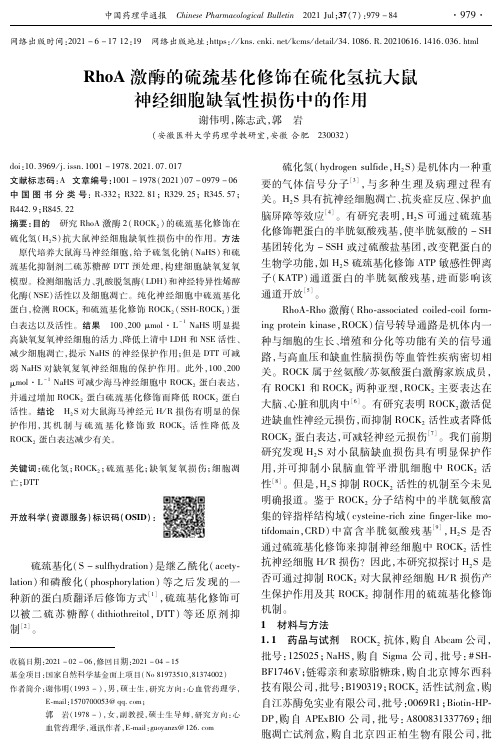
·979·
网络出版时间:2021-6-1712:19 网络出版地址:https://kns.cnki.net/kcms/detail/34.1086.R.20210616.1416.036.html
·980·
中国药理学通报 ChinesePharmacologicalBulletin 2021Jul;37(7)
号:20200820;二硫 苏 糖 醇 (DTT),购 自 阿 拉 丁 试 剂 有限公司,批号:D8220。 1.2 仪器 流式细胞仪(美国 BD公司);凝胶电泳 仪和电泳槽 (美国 BIORAD公司);TGL16H超速 冷冻离心机(珠海黑马仪器有限公司);细胞培养箱 (美国 Thermo公司) 1.3 动物 SPF级 SD大鼠新生鼠,购自安徽医科 大学实验动物中心,实验动物合格证号:SCXK(皖) 2017001。 1.4 方法 1.4.1 原代培养大鼠海马神经细胞[10] 取新生 24 h内的 SD大鼠,在麻醉状态下断头取脑并剥离海马 组织,0.125%胰酶液消化 20min,加入 10% FBS的 DMEM/F12完全培 养 基,巴 氏 吸 管 将 组 织 吹 散,70 μm细胞过滤器过滤,1000r·min-1常温离心 5min 并留沉淀。加入完全培养基重悬细胞,调整细胞数 目为 1×107个·L-1,接种于预先用多聚赖氨酸包 被好的 6孔板中,24h后用专用培养基(Neurobasal +2% B27+05mmol·L-1 Lglutamine+1%青霉 素 -链霉素溶液)半量换液,每隔 3d全量换液。
mLHENS缓冲液吹打溶解,加入 50μL链霉亲和素 琼脂糖珠,室温避光放置 24h。再 12000r·min-1 离心 2min后弃上清,用 HENS缓冲液重悬琼脂糖 珠并反复离心洗涤 3次,用洗脱缓冲液洗脱琼脂糖 珠后得到纯化的硫巯基化蛋白。 1.4.3 ROCK2 或 硫 巯 基 化 ROCK2(SSHROCK2) 的蛋白含量检测 神经元总蛋白或硫巯基化蛋白中 的 ROCK2含量分别用 Westernblot法测定。将 100 μg的总蛋白或硫巯基化蛋白置 100℃ 变性后,在 12% SDS聚丙稀酰胺凝胶中电泳后将蛋白转膜至 PVDF膜。5%脱脂牛奶中封闭 15h,ROCK2 一抗 孵育过 夜。次 日 加 入 HRP标 记 的 二 抗 孵 育 1h。 TBST洗膜后用 ECL化学发光显色液显影并拍照以 兔抗 βactin多克隆抗体为内参照,ImageJ进行灰 度值分析。 1.4.4 ROCK2活性检测 将培养 8d的海马神经 元细胞随 机 分 为 NS对 照 组 和 NaHS(200μmol· L-1)组。NaHS或生理盐水处理 24h后,将 NaHS组 进行硫巯基化蛋白分离纯化。采用 Westernblot法 定量分析各组 ROCK2蛋白的浓度,以灰度值的比值 来调整 ROCK2 蛋白的浓度,待浓度一致后再进行 ROCK2活性检测。将蛋白样品加入到 96孔板中, 并设置空白孔和标准孔,按试剂盒说明书进行操作, 以空白孔调零,450nm波长测吸光度。 1.4.5 神经细胞缺氧复氧损伤模型的建立 将原 代海 马 神 经 细 胞 随 机 分 为 正 常 对 照 组、模 型 组、 NaHS(50、100、200μmol·L-1)组、硫巯基化抑制剂 DTT组以及 NaHS(200μmol· L-1)+DTT组。除 正常对照组外,细胞预处理 24h后弃去培养基加入 缺氧液,置于 90% N2 -10% CO2 三气培养箱中孵 育 4h,再更换成完全培养基置于正常三气培养箱 (37℃、5%CO2)孵育 12h,进行后续实验。 1.4.6 CCK8法检测细胞活力 取缺氧 4h/复氧 12h铺满 96孔板(100μL/孔)的神经元,每孔加入 10μLCCK8试剂,培养箱中孵育 1h后用酶标仪测 定 450nm处的吸光度,计算细胞活力。 1.4.7 检测培养上清中 LDH、NSE水平 使用试 剂盒检测细胞培养上清中 LDH和 NSE活性。 1.4.8 细胞凋亡检测 将细胞用不含 EDTA的胰 酶消化吹打分离出后,加入 1∶3稀释的结合缓冲 液。将 5μLAnnexinV和 10μL碘化丙啶(PI)加入 100μL细胞悬液中避光放置 5min,立即检测各组 凋亡率。 1.4.9 数据分析 使用 GraphpadPrism8软件对 数据进行分析,采用 t检验进行两组间比较,单因素
缺氧预处理对人心肌细胞缺氧复氧损伤的影响及其机制

缺氧预处理对人心肌细胞缺氧复氧损伤的影响及其机制
刘秀华;费宇行
【期刊名称】《北京医科大学学报》
【年(卷),期】1997(029)006
【摘要】目的:探讨缺氧预处理(PC)对于人类心肌细胞缺氧复氧(H/R)损伤的影响及其机制。
方法:在体外分离的人心房和心室肌细胞的H/R模型上观察缺氧PC的作用,及蛋白激酶C(PKC)抑制剂与蛋白磷酸酶激动剂和抑制剂对PC现象的影响。
结果:缺氧PC明显减轻H/R造成的心肌细胞损伤,PKC抑制剂H7和蛋白磷酸酶激动剂BDM分别完全消除PC的细胞保护,而蛋白磷酸酶抑制剂OA则能模拟PC的上述保护效应。
结论:人类
【总页数】4页(P493-496)
【作者】刘秀华;费宇行
【作者单位】中国人民解放军总医院老年心血管病研究所;北京医科大学心血管基础研究所
【正文语种】中文
【中图分类】R542.2
【相关文献】
1.缺氧预处理对培养的人血管平滑肌细胞缺氧复氧损伤的影响 [J], 刘秀华;费宇行
2.有氧运动对老年人心肌细胞以及功能的影响机制研究进展 [J], 刘彬;刘忠民
3.有氧游泳运动对中老年人心肌细胞以及功能的影响机制研究 [J], 戴伟宇
4.二甲双胍对H9c2心肌细胞缺氧复氧损伤中FUNDC1介导线粒体自噬的影响及其机制 [J], 王鑫; 刘乃丰
5.β-榄香烯调控miR-130b-5p/NF-κB信号通路对心肌细胞缺氧复氧损伤的影响及机制 [J], 邓瑞;卢小伟;马珍珍;王威
因版权原因,仅展示原文概要,查看原文内容请购买。
缺氧后处理对缺氧/复氧心肌细胞的保护作用及其机理研究
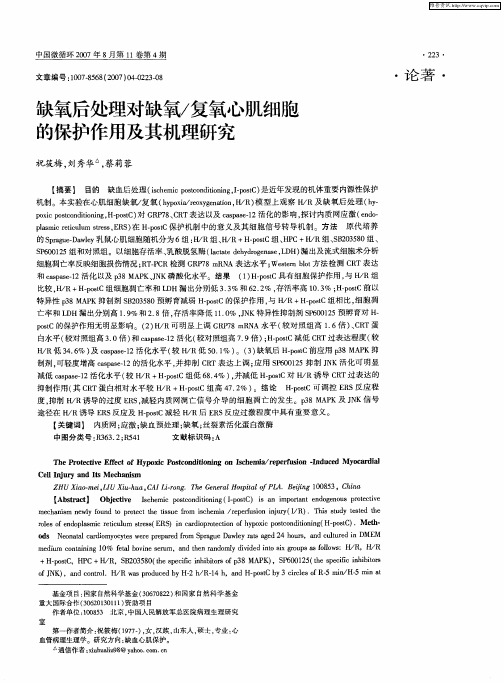
机制 。本实验在心肌 细胞缺 氧/ 氧( yoi royeao , / 模型上 观察 H R及缺氧 后处理 ( y 复 hpxa exgnf n H R) / i / h—
T o e tv fe t o p x c P s c n iin n H Ic e  ̄ /r p r u in -nd c d M y c r il hePr tc i e Ef c f Hy o i o t o d t i g O s h n i e e f so I u e o a o a da
pxc ot n ioigH—ot ) G P 8 C T表 达以及 csae1 oi p s odt n , p s 对 R 7 、 R e i n C aps.2活化的影响 , 探讨 内质 网应激 ( no ed—
p m er i lm s esE S 在 H-ot 护机制 中的意 义及 其细胞信号 转导机 制 。方法 l i ec u t s,R ) s a tu r ps C保
抑 制作用 ( C T蛋 白 其 R 相对 水平较 H R+ —oC组 高 4.% ) / H ps t 72 。结论
H ps . t o C可调控 E S反应 程 R
度. 抑制 H R诱导的过度 E S 减轻内质网凋 亡信号介 导的细胞凋 亡 的发生 。p 8M P / R, 3 A K及 J K信 号 N
【 bt c】 O j t e I hmcpsodi i (-o C i a prn edg osp t te A s at r be v s e i oeni n g I s ) s ni oat noe u re i c i c t t n pt o m t n o cv
硫化氢对氧应激所致心肌细胞损伤的影响及机制

·实验研究·[文章编号]1007-3949(2011)19-04-0310-05硫化氢对氧应激所致心肌细胞损伤的影响及机制边云飞,秦卫伟,宋晓苏,肖传实(山西医科大学第二医院心内科,山西省太原市030001)[关键词]心肌细胞;硫化氢;氧化应激;PI3K/Akt[摘要]目的探讨硫化氢供体硫氢化钠对过氧化氢诱导心肌细胞氧化应激损伤的保护机制。
方法采用胶原酶消化分离培养SD大鼠乳鼠心肌细胞,过氧化氢诱导建立氧化应激模型。
经硫氢化钠和LY294002预处理探讨硫化氢对过氧化氢诱导心肌细胞损伤的保护作用,观察心肌细胞形态学变化,检测乳酸脱氢酶、丙二醛的含量和超氧化物歧化酶的活性,Western blot检测凋亡相关蛋白表达,流式细胞术检测心肌细胞的凋亡。
结果过氧化氢可引起乳鼠心肌细胞乳酸脱氢酶、丙二醛含量升高,Akt磷酸化水平下降,Bcl-2/Bad比值降低,细胞凋亡率升高(P<0.05);硫氢化钠预处理能减轻过氧化氢引起的心肌细胞损伤,乳酸脱氢酶、丙二醛含量下降,Akt磷酸化水平升高,Bcl-2/Bad比值升高,细胞凋亡率下降(P<0.05);PI3K/Akt特异性阻断剂LY294002能部分减轻硫氢化钠的保护作用(P<0.05)。
结论硫氢化钠预处理能使Akt的磷酸化水平升高,Bcl-2/Bad比值升高,在一定程度上减轻过氧化氢诱导的心肌细胞损伤及凋亡,硫化氢可能通过激活PI3K/Akt信号转导通路发挥保护作用。
[中图分类号]R541[文献标识码]ACardioprotective Mechanism of Hydrogen Sulfide Attenuating Hydrogen Peroxide-in-duced Rat Neonatal Cardiomyocytes InjuryBIAN Yun-Fei,QIN Wei-Wei,SONG Xiao-Su,and XIAO Chuan-Shi(Department of Cardiology,The Second Hospital of Shanxi Medical University,Taiyuan,Shanxi030001,China)[KEY WORDS]Cardiomyocytes;Hydrogen Sulfide;Oxidative Stress;PI3K/Akt[ABSTRACT]Aim To study the cardioprotective mechanism of hydrogen sulfide(H2S)on oxidative stress induced by hydrogen peroxide.Methods Primary-cultured cardiomyocytes were obtained from neonatal rats,an oxidativestress injury model was established by exposing the cells to H2O2for2h.To study the cardioprotective mechanism of hy-drogen sulfide(H2S)on oxidative stress induced by hydrogen peroxide,the cells were pre-incubated with ly294002for30 min.The morphology change of cardiomyocytes was observed by inverted phase contrast microscope,the activities of lac-tate dehydrogenase(LDH)and superoxide dismutase(SOD),and content malondialdehyde(MDA)were determined,the activation of the PI3K/Akt signal pathway was observed by Western blotting,the cardiomyocytes apoptosis was detected byAnnexinV/PI flow cytometry.Results After exposing to H2O2for2h,the release of LDH,MDA and apoptosis wereincreased,the activities of SOD and ratio of Bcl-2/Bad were decreased(P<0.05).After pretreated with sodium hydro-sulfide(NaHS)for30mins,the injury effect was attenuated,moreover,the phosphorylation of Akt,Bad and ratio of Bcl-2/ Bad were upregulated.LY294002could block the protection effect of NaHS partly.Conclusion H2S can attenuate hydrogen peroxide-induced rat neonatal cardiomyocytes injury,which may involve the PI3K/Akt pathway.近年来,活性氧对心脏的损伤作用越来越引起人们的重视。
硫化氢减少缺氧时人脐静脉内皮细胞的凋亡
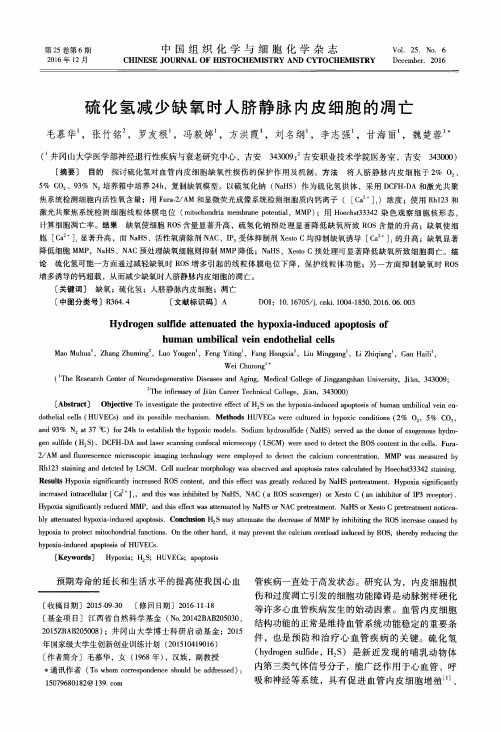
balanced salt
solution,HBSS)缓
2硫化氢抑制缺氧诱导人脐静脉内皮细胞钙离子 浓度上升 采用钙荧光探针Fura-2/AM和钙离子成像系统 (CellR_MT20)检测发现,缺氧使人脐静脉内皮细 胞[ca2+].显著升高,引起钙超载。3001xmol/L
NaHS、1 txmolfLXesto C、1mmoL/L
NAC pretreatment.NariS
Xesto
bly attenuated hypoxia・induced apoptosis.Conclusion心S may attenuate the decrease of MMP by hypoxia
to
inhibiting
the ROS increase caused by
材料与方法 1材料 NariS、DCFH.DA、IR受体抑制剂Xestospongin C(Xesto C)购自Sigma公司;Fura-2/AM、胰酶购
Hoechst33342染色检测细胞凋亡率 细胞处理后PBS洗两次,4%多聚甲醛室温固
定15min;PBS洗两次,lOng/ml Hoechst33342染 核5min;PBS冲洗两次,荧光显微镜下观察,各组
冲液(pH 7.4)洗3次,加入5肛mol/L的DCFH- DA于37cc避光孵育50min;清洗3次,激光共聚 焦显微镜(激发波长488nm,发射波长525nm)随 机取3个视野拍照,重复3次,以平均荧光强度表 示活性氧含量。 4细胞质内钙离子浓度的检测 细胞接种于圆形玻片,用300¨mol/L NaHS预 处理30min后缺氧处理24h,HBSS清洗3次,加入 1.5I山mol/L的Fura-2/AM避光于37℃孵育45min,
牛磺酸对培养的心肌细胞缺氧再给氧损伤的保护作用
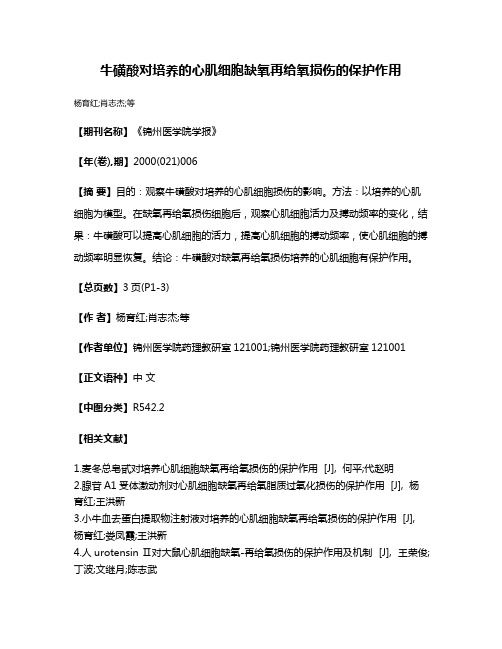
牛磺酸对培养的心肌细胞缺氧再给氧损伤的保护作用
杨育红;肖志杰;等
【期刊名称】《锦州医学院学报》
【年(卷),期】2000(021)006
【摘要】目的:观察牛磺酸对培养的心肌细胞损伤的影响。
方法:以培养的心肌细胞为模型。
在缺氧再给氧损伤细胞后,观察心肌细胞活力及搏动频率的变化,结果:牛磺酸可以提高心肌细胞的活力,提高心肌细胞的搏动频率,使心肌细胞的搏动频率明显恢复。
结论:牛磺酸对缺氧再给氧损伤培养的心肌细胞有保护作用。
【总页数】3页(P1-3)
【作者】杨育红;肖志杰;等
【作者单位】锦州医学院药理教研室121001;锦州医学院药理教研室121001【正文语种】中文
【中图分类】R542.2
【相关文献】
1.麦冬总皂甙对培养心肌细胞缺氧再给氧损伤的保护作用 [J], 何平;代赵明
2.腺苷A1受体激动剂对心肌细胞缺氧再给氧脂质过氧化损伤的保护作用 [J], 杨育红;王洪新
3.小牛血去蛋白提取物注射液对培养的心肌细胞缺氧再给氧损伤的保护作用 [J], 杨育红;娄凤霞;王洪新
4.人urotensin Ⅱ对大鼠心肌细胞缺氧-再给氧损伤的保护作用及机制 [J], 王荣俊;丁波;文继月;陈志武
5.儿茶素单体对心肌细胞缺氧再给氧损伤的保护作用及机制研究 [J], 叶锦霞;王岚;梁日欣;杨滨
因版权原因,仅展示原文概要,查看原文内容请购买。
气体分子硫化氢对心脏缺血再灌注保护机制的探讨
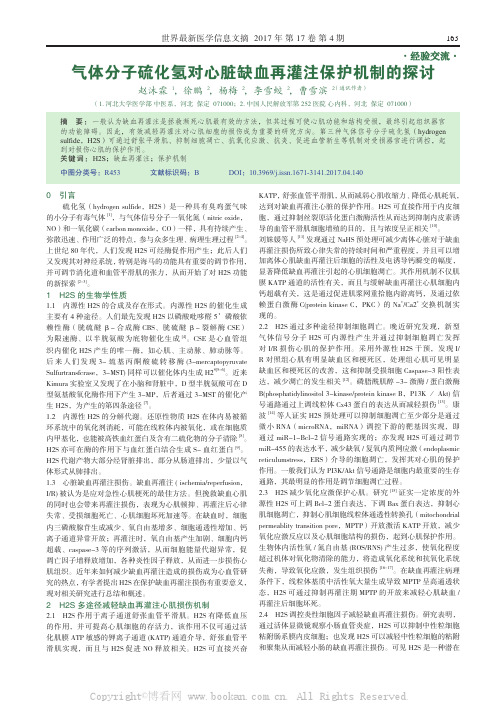
世界最新医学信息文摘 2017年 第17卷 第4期163·经验交流·气体分子硫化氢对心脏缺血再灌注保护机制的探讨赵沐霖1,徐鹏2,杨梅2,李雪蛟2,曹雪滨2(通讯作者)(1.河北大学医学部 中医系,河北 保定 071000;2.中国人民解放军第252医院 心内科,河北 保定 071000)0 引言硫化氢(hydrogen sulfide,H2S)是一种具有臭鸡蛋气味的小分子有毒气体[1],与气体信号分子一氧化氮(nitric oxide,NO)和一氧化碳(carbon monoxide,CO)一样,具有持续产生、弥散迅速、作用广泛的特点,参与 众多生理、病理生理过程[2-4]。
上世纪80年代,人们发现H2S可经酶促作用产生;此后人们又发现其对神经系统,特别是海马的功能具有重要的调节作用,并可调节消化道和血管平滑肌的张力,从而开始了对H2S功能的新探索[2-3]。
1 H2S的生物学性质1.1 内源性H2S的合成及存在形式。
内源性H2S的催化生成主要有4种途径。
人们最先发现H2S以磷酸吡哆醛5’磷酸依赖性酶(胱硫醚β-合成酶CBS、胱硫醚β-裂解酶CSE )为限速酶、以半胱氨酸为底物催化生成[4]。
CSE是心血管组织内催化H2S产生的唯一酶,如心肌、主动脉、肺动脉等。
后来人们发现3-巯基丙酮酸硫转移酶(3-mercaptopyruvate Sulfurtransfcrase,3-MST)同样可以催化体内生成H2S[5-6]。
近来Kimura实验室又发现了在小脑和肾脏中,D型半胱氨酸可在D 型氨基酸氧化酶作用下产生3-MP,后者通过3-MST的催化产生H2S,为产生的第四条途径[7]。
1.2 内源性H2S的分解代谢。
还原性物质H2S在体内易被循环系统中的氧化剂消耗,可能在线粒体内被氧化,或在细胞质内甲基化,也能被高铁血红蛋白及含有二硫化物的分子清除[8]。
H2S亦可在酶的作用下与血红蛋白结合生成S-血红蛋白[9]。
硫化氢的心脏保护作用

气体信号分子硫化氢的心脏保护作用研究进展【摘要】气体信号分子家族由一氧化氮、一氧化碳和硫化氢等内源性气体小分子组成,发挥重要的生物学效应。
已经证实硫化氢在多个系统中有重要的生理调节作用,本文重点综述其在心血管系统中的心脏保护作用,包括抑制心脏缺血再灌注损伤、负性调节心脏代谢消耗和抗心脏氧化应激等。
【关键词】气体;硫化氢;心脏1 内源性气体信号分子——硫化氢硫化氢(hydrogen sulfide,H2S)是一种无色,有很强的臭鸡蛋气味的有毒气体。
人类认识并研究其毒性作用已有300 多年的历史,然而H2S的生理作用直到上世纪90年代才被逐渐认识。
H2S在生物体内可由内源性酶催化生成,受体内代谢途径的调控,生理浓度下有特定生理功能,已经证实其在神经、心血管、内分泌、消化等多个系统中具有特定的生理调节作用。
H2S的体内浓度远远低于其产生毒性的浓度,它和一氧化氮(NO)、一氧化碳(CO)一并称为气体信号分子,组成气体信号分子家族[1,2]。
2 硫化氢在体内的合成调节H2S 是一种弱酸,在体内1/3 以气体H2S形式存在,2/3以硫氢化钠(NaHS)形式存在,H2S与NaHS 存在动态平衡,这样既保证了H2S 在体内的稳定,又不改变内环境的pH 值。
H2S在脂溶性溶剂中的溶解度为水中的5 倍,故可自由通过细胞膜[1]。
内源性H2S的生成可以通过酶促反应途径也可以通过非酶促途径。
在哺乳动物体内主要是酶促反应途径,以L-半胱氨酸为底物,由磷酸吡哆醛-5′-磷酸依赖性酶,主要是胱硫醚γ裂解酶(cystathionineγlyase,CSE)和胱硫醚β合成酶(cystathionine βsynthase,CBS)催化而成,其两个终产物是铵和丙酮酸盐。
研究发现CSE和CBS 这两种酶的分布具有组织特异性,在心血管系统中CBS表达很少[3],CBS是主要的硫化氢合成酶。
研究发现心脏高表达CSE,高于主动脉,而低于脑组织,其内源性H2S的生成量为(50.2±2.1)μmol/mg蛋白,生成率为(18.64±4.49)nmol/min·g蛋白,表明心脏也是内源性H2S的主要生成来源[4],另外心梗组织中CSE也有表达[5]。
硫化氢对急性心肌缺血大鼠心肌线粒体损伤的影响
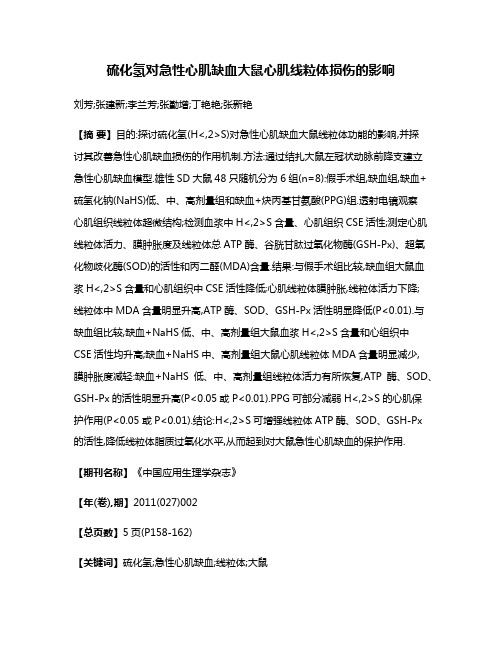
硫化氢对急性心肌缺血大鼠心肌线粒体损伤的影响刘芳;张建新;李兰芳;张勤增;丁艳艳;张新艳【摘要】目的:探讨硫化氢(H<,2>S)对急性心肌缺血大鼠线粒体功能的影响,并探讨其改善急性心肌缺血损伤的作用机制.方法:通过结扎大鼠左冠状动脉前降支建立急性心肌缺血模型.雄性SD大鼠48只随机分为6组(n=8):假手术组,缺血组,缺血+硫氢化钠(NaHS)低、中、高剂量组和缺血+炔丙基甘氨酸(PPG)组.透射电镜观察心肌组织线粒体超微结构;检测血浆中H<,2>S含量、心肌组织CSE活性;测定心肌线粒体活力、膜肿胀度及线粒体总ATP酶、谷胱甘肽过氧化物酶(GSH-Px)、超氧化物歧化酶(SOD)的活性和丙二醛(MDA)含量.结果:与假手术组比较,缺血组大鼠血浆H<,2>S含量和心肌组织中CSE活性降低;心肌线粒体膜肿胀,线粒体活力下降;线粒体中MDA含量明显升高,ATP酶、SOD、GSH-Px活性明显降低(P<0.01).与缺血组比较,缺血+NaHS低、中、高剂量组大鼠血浆H<,2>S含量和心组织中CSE活性均升高;缺血+NaHS中、高剂量组大鼠心肌线粒体MDA含量明显减少,膜肿胀度减轻:缺血+NaHS低、中、高剂量组线粒体活力有所恢复,ATP酶、SOD、GSH-Px的活性明显升高(P<0.05或P<0.01).PPG可部分减弱H<,2>S的心肌保护作用(P<0.05或P<0.01).结论:H<,2>S可增强线粒体ATP酶、SOD、GSH-Px的活性,降低线粒体脂质过氧化水平,从而起到对大鼠急性心肌缺血的保护作用.【期刊名称】《中国应用生理学杂志》【年(卷),期】2011(027)002【总页数】5页(P158-162)【关键词】硫化氢;急性心肌缺血;线粒体;大鼠【作者】刘芳;张建新;李兰芳;张勤增;丁艳艳;张新艳【作者单位】河北省医学科学院药研室,石家庄,050021;河北省医学科学院药研室,石家庄,050021;河北省医学科学院药研室,石家庄,050021;河北省医学科学院药研室,石家庄,050021;河北省医学科学院药研室,石家庄,050021;河北省医学科学院药研室,石家庄,050021【正文语种】中文【中图分类】R331心肌缺血指冠状动脉供血绝对或相对不足或冠状动脉供血中断而导致心肌急性暂时性的或者持久性的缺血缺氧,从而导致心肌功能紊乱并伴有严重的细胞损伤;然而在心肌细胞的损伤和死亡中,线粒体首当其害。
211246893_七氟醚后处理对缺氧复氧诱导的H9C2心肌细胞焦亡及TXNIP

doi:10.3969/j.issn.1000-484X.2023.05.005七氟醚后处理对缺氧复氧诱导的H9C2心肌细胞焦亡及TXNIP/NLRP3 通路的影响①刘金川丁汉琳李丽楠②(湖北文理学院附属医院,襄阳市中心医院疼痛科,襄阳 441021)中图分类号R542.2 文献标志码 A 文章编号1000-484X(2023)05-0922-06[摘要]目的:基于硫氧还蛋白结合蛋白(TXNIP)/核苷酸结合寡聚化结构域样受体蛋白3(NLRP3)通路探究七氟醚后处理(SPostC)对缺氧复氧(HR)诱导的H9C2心肌细胞焦亡的影响。
方法:体外培养H9C2心肌细胞,将细胞分为4组:正常对照组(NC组)、HR组、HR+SPostC组、HR+SPostC+TXNIP/NLRP3通路抑制剂白藜芦醇组(HR+SPostC+RES组)。
采用CCK-8检测细胞活力;采用乳酸脱氢酶(LDH)试剂盒检测LDH含量;采用碘化丙啶(PI)染色法检测细胞膜孔的形成;采用Westernblot法检测细胞焦亡相关蛋白Caspase-1、IL-1β、IL-18及TXNIP/NLRP3通路相关蛋白TXNIP、NLRP3的表达;采用实时荧光定量PCR法检测TXNIP/NLRP3通路相关基因TXNIP、NLRP3的表达。
结果:与NC组相比,其余3组细胞活力显著降低,而LDH 释放量、PI染色阳性率以及Caspase-1、IL-1β、IL-18、TXNIP和NLRP3的表达明显升高(P<0.05);与HR组相比,HR+SPostC组和HR+SPostC+RES组细胞活力显著升高(P<0.05),而LDH释放量、PI染色阳性率以及Caspase-1、IL-1β、IL-18、TXNIP和NLRP3的表达明显降低(P<0.05);与HR+SPostC组相比,HR+SPostC+RES组细胞活力显著升高(P<0.05),而LDH释放量、PI染色阳性率以及Caspase-1、IL-1β、IL-18、TXNIP和NLRP3的表达明显降低(P<0.05)。
外源性H2S恢复缺氧后适应对衰老H9C2细胞的保护作用及机制

外源性H2S恢复缺氧后适应对衰老H9C2细胞的保护作用及机制孙伟铭;张源洲;温馨;席雨鑫;袁迪;王跃虹;魏璨;徐长庆;李鸿珠【摘要】目的:探讨外源性硫化氢(H2S)恢复缺氧后适应对衰老H9C2细胞的保护作用及相关机制.方法:H9C2细胞(心肌细胞系)用30μmol/L过氧化氢(H2O2)处理2h后再培养3d,诱导生成衰老细胞.衰老H9C2细胞被随机分5组(n=8):正常组(Control)、缺氧/复氧组(H/R)、H/R+NaHS组、缺氧后适应(PC)组、PC+NaHS 组.缺氧/复氧(H/R)模型:衰老H9C2细胞用缺氧液(无血清、无糖培养基,pH=6.8)培养3h,然后正常培养6h;缺氧后适应(PC)模型:方法同H/R模型,缺氧结束复氧前连续进行3次5 min间隔的复氧/再缺氧处理,随后复氧6h.ELISA试剂盒分别检测大鼠晚期糖基化终末产物(AGEs)含量和caspase-3活性;CCK-8试剂盒检测细胞活力;DCFH-DA染色检测活性氧(ROS)水平;Hoechst 33342染色检测细胞凋亡率;Real-time PCR检测相关基因mRNA水平.结果:30 μmol/L H2O2可诱导H9C2细胞衰老但不会导致其凋亡;与Control组比较,H/R和PC均降低细胞活力,增加细胞凋亡率、ROS水平及caspase-3、caspase-9和Bcl-2 mRNA水平(P<0.01);且PC组与H/R组比较,上述指标变化无明显差异;在H/R和PC组加入NaHS,可显著提高细胞活力,降低细胞凋亡率和氧化应激;PC+NaHS对上述指标的作用明显强于H/R+NaHS.结论:外源性H2S能够恢复PC对衰老H9C2细胞的保护作用,其机制与抑制氧化应激和细胞凋亡有关.【期刊名称】《中国应用生理学杂志》【年(卷),期】2018(034)004【总页数】5页(P289-293)【关键词】硫化氢;缺氧/复氧;缺氧后适应;H9C2细胞;细胞凋亡【作者】孙伟铭;张源洲;温馨;席雨鑫;袁迪;王跃虹;魏璨;徐长庆;李鸿珠【作者单位】哈尔滨医科大学基础医学院病理生理学教研室,黑龙江哈尔滨150086;哈尔滨医科大学基础医学院病理生理学教研室,黑龙江哈尔滨150086;哈尔滨医科大学基础医学院病理生理学教研室,黑龙江哈尔滨150086;哈尔滨医科大学基础医学院病理生理学教研室,黑龙江哈尔滨150086;哈尔滨医科大学基础医学院病理生理学教研室,黑龙江哈尔滨150086;哈尔滨医科大学基础医学院病理生理学教研室,黑龙江哈尔滨150086;哈尔滨医科大学基础医学院病理生理学教研室,黑龙江哈尔滨150086;哈尔滨医科大学基础医学院病理生理学教研室,黑龙江哈尔滨150086;哈尔滨医科大学基础医学院病理生理学教研室,黑龙江哈尔滨150086【正文语种】中文【中图分类】R363.2近来研究证实,硫化氢 (hydrogen sulfide, H2S) 已被认为是继一氧化氮 (nitric oxide, NO) 和一氧化碳 (carbon monoxide, CO) 后新发现的第三个气体信号分子[1]。
硫化氢抑制离体灌流大鼠急性心肌缺血所致心肌细胞凋亡研究
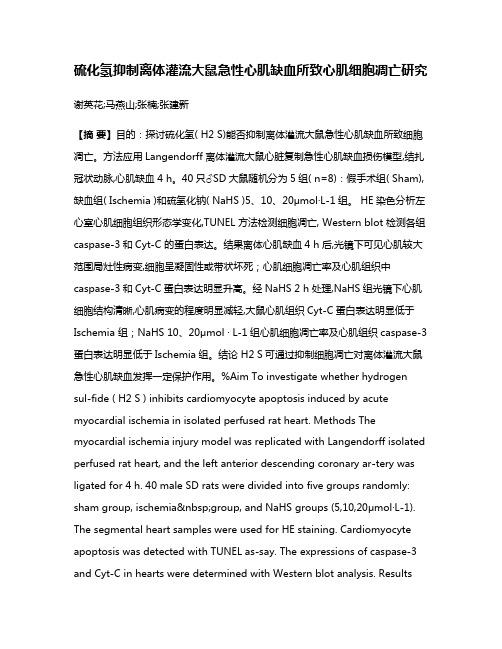
硫化氢抑制离体灌流大鼠急性心肌缺血所致心肌细胞凋亡研究谢英花;马燕山;张楠;张建新【摘要】目的:探讨硫化氢( H2 S)能否抑制离体灌流大鼠急性心肌缺血所致细胞凋亡。
方法应用Langendorff 离体灌流大鼠心脏复制急性心肌缺血损伤模型,结扎冠状动脉,心肌缺血4 h。
40只♂SD大鼠随机分为5组( n=8):假手术组( Sham),缺血组( Ischemia )和硫氢化钠( NaHS )5、10、20μmol·L-1组。
HE染色分析左心室心肌细胞组织形态学变化,TUNEL 方法检测细胞凋亡, Western blot 检测各组caspase-3和Cyt-C 的蛋白表达。
结果离体心肌缺血4 h后,光镜下可见心肌较大范围局灶性病变,细胞呈凝固性或带状坏死;心肌细胞凋亡率及心肌组织中caspase-3和Cyt-C蛋白表达明显升高。
经NaHS 2 h处理,NaHS组光镜下心肌细胞结构清晰,心肌病变的程度明显减轻,大鼠心肌组织Cyt-C蛋白表达明显低于Ischemia 组;NaHS 10、20μmol · L-1组心肌细胞凋亡率及心肌组织caspase-3蛋白表达明显低于Ischemia组。
结论 H2 S可通过抑制细胞凋亡对离体灌流大鼠急性心肌缺血发挥一定保护作用。
%Aim To investigate whether hydrogen sul-fide ( H2 S ) inhibits cardiomyocyte apoptosis induced by acute myocardial ischemia in isolated perfused rat heart. Methods The myocardial ischemia injury model was replicated with Langendorff isolated perfused rat heart, and the left anterior descending coronary ar-tery was ligated for 4 h. 40 male SD rats were divided into five groups randomly: sham group, ischemia group, and NaHS groups (5,10,20μmol·L-1). The segmental heart samples were used for HE staining. Cardiomyocyte apoptosis was detected with TUNEL as-say. The expressions of caspase-3 and Cyt-C in hearts were determined with Western blot analysis. ResultsMyocardial cells were found to show serious disorder and coagulated zonal necrosis under light microscope, the apoptotic rate of cardiomyocytes and the expression of caspase-3 and Cyt-C were significantly increased af-ter ischemia for 4h. Perfusion of NaHS resulted in more clear cell morphology and milder pathologic chan-ges of myocardiocytes according to the HE staining a-nalysis, and the significant decrease of expression of Cyt-C. After perfusion of 10,20 μmol·L-1 NaHS,the apoptotic rate of cardiomyocytes and the expression of caspase-3 were significantly decreased. Conclusion H2 S has certain protective effects on acute myocardial ischemic injury in isolated perfused rat heartvia inhibi-ting cardiomyocyte apoptosis.【期刊名称】《中国药理学通报》【年(卷),期】2014(000)011【总页数】5页(P1543-1546,1547)【关键词】硫化氢;急性心肌缺血;Langendorff;大鼠;细胞凋亡;心肌保护【作者】谢英花;马燕山;张楠;张建新【作者单位】河北科技大学药学系,河北石家庄050018;石家庄市中医院放射科,河北石家庄 050051;河北省医学科学院,河北石家庄 050021;河北省医学科学院,河北石家庄 050021【正文语种】中文【中图分类】R-332;R322.11;R329.25;R542.202.2;R542.205心肌缺血性损伤严重危害人类健康,是由冠状动脉供血不足,心肌急剧的暂时的缺血和缺氧引起。
硫化氢可能成为一种新的神经保护药物

硫化氢可能成为一种新的神经保护药物发表时间:2020-12-17T13:12:25.070Z 来源:《医师在线》2020年26期作者:赵晨亮[导读] 急性脑梗死是临床常疾病,其死亡率、致残率、复发率高赵晨亮浙江大学医学院附属第四医院浙江省金华市 321000急性脑梗死是临床常疾病,其死亡率、致残率、复发率高,严重影响着人类的生存质量。
迄今世界范围内对本病尚缺少疗效明显且安全的药物医治方式。
目前最有效的方法就是对闭塞血管的快速再通和适时的再灌注,这种超早期溶栓治疗确实使少部分患者获益,但由于溶栓有严格的适应症和禁忌症,同时也可致再灌注损伤,其应用受到很大的限制。
故急性脑梗死的治疗方案是医学界关注的焦点。
脑缺血后处理(Ischemic Postconditioning, IPO)可以减轻脑缺血/再灌注损伤。
IPO 通过激活蛋白激酶,阻断凋亡,抑制炎症和氧化应激等缩小脑梗死体积,减少神经元丢失和减轻神经功能缺损。
在动物实验中已经证实,硫化氢,低氧[1],异氟烷[2],异丙酚[3]等作为后处理可减轻脑缺血再灌注损伤。
对急性缺血卒中最有效的方法就是对闭塞血管的快速再通和适时地再灌注,但后者也可致再灌注损伤[4]。
由于急性卒中难以预测,使缺血预处理(Ischemic Preconditioning, IPC)的应用受到限制。
研究已经证实,后处理是脑缺血再灌注治疗中安全有效的脑保护策略。
因此开展各种后处理方式的基础及临床研究,将有利于开发后处理“模拟”药物,减轻脑缺血再灌注损伤,改善卒中患者的存活及长期预后。
目前 IPO 及一些药学策略后处理的神经保护作用已经在多种动物模型中得到证实,包括局灶脑缺血的后处理模型;全脑缺血的后处理模型等,但是各种后处理方式的神经保护机制仍未完全阐明,对其保护机制的研究有助于明确机体潜在的内源性保护作用,为临床药物的研发开拓新的思路。
硫化氢神经保护效应的研究现状:长久以来,硫化氢(hydrogen sulfide, H2S)被认为是一种有毒物质,直到最近,研究发现低浓度的H2S 在正常生理过程中扮演着重要角色[5]。
硫化氢通过抑制iNOS-NO通路对抗化学性缺氧引起的PC12细胞损伤

硫化氢通过抑制iNOS-NO通路对抗化学性缺氧引起的PC12细胞损伤郑东诞;兰爱平;莫利求;杨战利;杨春涛;王秀玉;郭润民;陈培熹;冯鉴强【期刊名称】《中山大学学报(医学科学版)》【年(卷),期】2011(032)006【摘要】[目的]探讨硫化氢(H2S)是否通过抑制iNOS-NO通路对抗化学性缺氧诱导的PC12细胞损伤.[方法]应用化学性低氧模拟剂氯化钴(CoCl2)处理PC12细胞建立化学性缺氧损伤模型.应用CCK-8比色法检测细胞存活率;Hoechst33258染色法观察细胞凋亡的形态学改变;PI染色流式细胞仪检测细胞凋亡率;Griess试剂盒检测细胞培养液中的亚硝酸盐(NO的代谢物)的浓度;Western blot法检测iNOS蛋白的表达水平.[结果]应用600 μmol/L CoCl2处理PC12细胞24 h可使诱导型一氧化氮合酶(iNOS)表达明显增多;在应用600 μmol/L CoCl2处理PC12细胞前30 min,应用400 μmol/L NaHS(H2S的供体)预处理细胞不仅可明显地抑制CoCl2诱导的iNOS表达及NO生成的增多,还能保护PC12细胞对抗600μmol/L CoCl2引起的损伤,使细胞存活率升高,凋亡细胞数目减少;在CoCl2损伤PC12细胞前60 min应用iNOS抑制剂L-Canavanine( 10 μmol/L)预处理也能产生类似NaHS的作用.SB203580(p38MAPK特异性抑制剂)预处理60 min也可以下调CoCl2引起的iNOS高表达.[结论]iNOS-NO通路介导CoCl2引起PC12细胞的损伤作用;H2S通过抑制iNOS-NO通路对抗化学性缺氧诱导的PC12细胞损伤.%[Objective] To investigate whether hydrogen sulfide (H2S) protected PC 12 cells against chemical hypoxia-induced injury by inhibiting iNOS-NO pathway.[Method] PC12 cells were treated with cobalt chloride(CoCl2) to set up a chemical hypoxia-induced cellular injury model. Cell viability was tested by Cell Counter Kit (CCK-8); morphological changes of apoptotic cells were detected by Hoechst33258 staining; Apoptotic rate was evaluated by propidium iodide staining and flow cytometry (FCM) ; Nitrite accumulation, an indicator of nitrogen monoxidum (NO) production, was measured in cell culture supernatants using the Griess reagent; the expression of the inducible enzyme of NO (iNOS) was determined by Western blot assay. [Results]Exposure of PC 12 cells to 600 u.mol/L CoCl2 for 24 h significantly enhanced iNOS expression. Pretreatment with 400|xmol/LNaHS (a donor of H2S) for 30 min prior to exposure of PC 12 cells to 600 (jumol/L CoCl2 not only inhibited CoCl2-induced increase in expression of iNOS and NO production, but also protected PC 12 cells against injuries induced by 600 Jjimol/L CoCl2, enhancing cell viability and decreasing amount of apoptotic cells. Similarly, pretreatment with L-Canavanine (10 u,mol/L) , an inhibitor of iNOS for 60 min prior to exposureof PC 12 cells to CoCl2 also conferred the same cytoprotective effect of H2S. In addition, pretreatment with SB203580, an inhibitor ofp38MAPK, for 60 min prior exposure of PC 12 cells to 600 (Jimol/L C0CI2 could also down-regulate the expression of iNOS induced by CoCl2. [Conclussions] The iNOS-NO pathway mediates CoCl2-induced injury and H^S can protect PC 12 cells against chemical hypoxia-induced injury by inhibiting iNOS-NO pathway.【总页数】6页(P741-746)【作者】郑东诞;兰爱平;莫利求;杨战利;杨春涛;王秀玉;郭润民;陈培熹;冯鉴强【作者单位】中山大学附属第一医院黄埔院区心血管科;中山大学中山医学院生理学教研室;附属第一医院黄埔院区麻醉科,广东广州510080;中山大学中山医学院生理学教研室;中山大学中山医学院生理学教研室;中山大学中山医学院生理学教研室;中山大学中山医学院生理学教研室;中山大学中山医学院生理学教研室;中山大学中山医学院生理学教研室【正文语种】中文【中图分类】Q28【相关文献】1.PI3K/Akt信号通路在硫化氢保护PC12细胞对抗化学性缺氧损伤的作用 [J], 孟金兰;陈雅嘉;陈红;董艳芬;邢德刚;梁燕玲;兰爱平;冯鉴强2.热休克蛋白90在硫化氢保护PC12细胞对抗化学性缺氧损伤中的作用 [J], 孟金兰;兰爱平;杨春涛;杨战利;王立伟;陈丽新;朱琳燕;陈培熹;冯鉴强3.硫化氢通过抑制p38 MAPK保护PC12细胞对抗化学性缺氧损伤 [J], 兰爱平;梅卫义;孟金兰;胡芬;杨春涛;杨战利;陈培熹;冯鉴强4.硫化氢对抗化学性缺氧引起的心肌细胞损伤及其机制 [J], 廖新学;杨春涛;杨战利;李建平;王礼春;黄雪;郭瑞鲜;陈培熹;冯鉴强5.热休克蛋白90在硫化氢对抗化学性缺氧引起的心肌细胞损伤中的作用 [J], 李建平;杨战利;杨春涛;廖新学;黄雪;王礼春;陈培熹;冯鉴强因版权原因,仅展示原文概要,查看原文内容请购买。
硫化氢后处理对缺氧/复氧损伤心肌的保护及其机制-武汉大学学报

/ ⦠: 1 0. 1 4 1 8 8 . 1 6 7 1 8 8 5 2. 2 0 1 6. 0 3. 0 0 4 j
硫化氢后处理对缺氧 / 复氧损伤心肌的保护及其机制
祝晓莹1,2 邓 晶1 王桂美1 胡 敏1 丁雅澜1 严晓红1
1 2
武汉大学基础医学院生理学系 湖北 武汉 4 3 0 0 7 1
第3 7卷 第3期 2 0 1 6年5月
武汉大学学报 ( 医学版 ) M e d i c a l J o u r n a l o fWu h a nU n i v e r s i t y
V o l . 3 7N o . 3 M a . 2 0 1 6 y 文章编号 1 ( ) 6 7 1 8 8 5 2 2 0 1 6 0 3 0 3 5 8 0 5
∳ ∰ 1 ,⇌≏
1 , ˋ ∳ ∭∳
1 , Ω ∳ ∰
2
ˇ . ’
∰
∰∯ æ, ˋ æ ∰ 4 7 1 0 0 3,
≏‟ ˇ ∑ˇ
∰ ∰, ∳ ∰
Hale Waihona Puke ⦠∲ ˇ ∳ ˊ: T o i n v e s t i a t ew h e t h e rH2Sp o s t c o n d i t i o n i n r o t e c t sH 9 C 2c e l l sa a i n s t t h eh g gp g y / : o x i ar e o x e n a t i o n i n u r n d i t sm e c h a n i s m.Ω ˇ ‟ H 9 C 2c e l l sw e r er a n d o m l i v i d e di n t o p y g j ya yd : ( ) , / ( / ) , / / f o u rg r o u s c o n t r o lg r o u o n h o x i ar e o x e n a t i o ng r o u H R+2 0 0μ m o lL p p c y p y g p HR / / / / H R+P AG) .T h ec e l l sm o r H R+N a H S) a n dH R+1 0μ m o l LP AG g r o u N a H Sg r o u p( p( h o l o a so b s e r v e db n v e r t e dm i c r o s c o e .T h ec e l la o t o s i sr a t e sw e r ed e t e c t e db I p g yw yi p p p yP s t a i n e df l o wc t o m e t r n d t h e e x r e s s i o n so fC S EmR NA w e r ed e t e r m i n e db e a l t i m eq u a n t i t a y ya p yr ( ) P C R . T h ep r o t e i ne x r e s s i o n s f o rp 5 0 AT F 6a n dG R P 7 8w e r eq u a n t i f i e db e s t t i v eP C R Q p yW : / e r nb l o t t i n . ∹‟ ˋ ∯ ˇ ‟ C o m a r e dw i t hH Rg r o u a H Sp o s t c o n d i t i o n i n o u l dr e d u c et h eh g p p,N gc y / r e o x e n a t i o n i n u r i nH 9 C 2c e l l sb o b s e r v i n t h e c e l l sm o r h o l o a n dd e t e c t i n t h e c e l l o x i a y g j y y g p g y g p
硫化氢对心室肌细胞触发活动及L型钙通道的影响
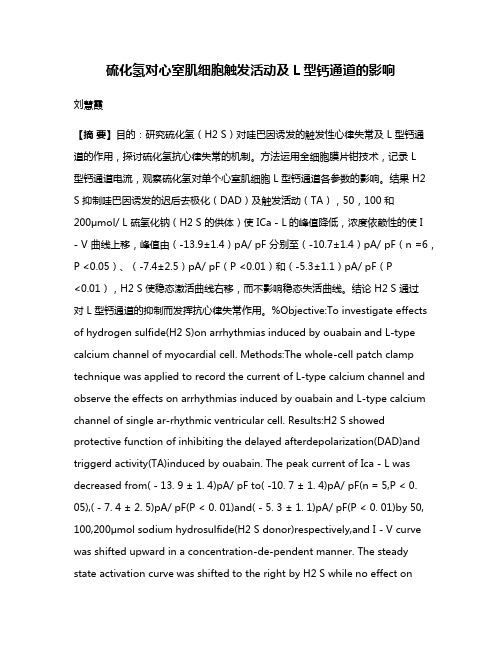
硫化氢对心室肌细胞触发活动及L型钙通道的影响刘慧霞【摘要】目的:研究硫化氢(H2 S)对哇巴因诱发的触发性心律失常及 L 型钙通道的作用,探讨硫化氢抗心律失常的机制。
方法运用全细胞膜片钳技术,记录 L型钙通道电流,观察硫化氢对单个心室肌细胞 L 型钙通道各参数的影响。
结果 H2 S 抑制哇巴因诱发的迟后去极化(DAD)及触发活动(TA),50,100和200μmol/ L 硫氢化钠(H2 S 的供体)使 ICa - L的峰值降低,浓度依赖性的使 I - V 曲线上移,峰值由(-13.9±1.4)pA/ pF 分别至(-10.7±1.4)pA/ pF(n =6,P <0.05)、(-7.4±2.5)pA/ pF(P <0.01)和(-5.3±1.1)pA/ pF(P<0.01),H2 S 使稳态激活曲线右移,而不影响稳态失活曲线。
结论 H2 S 通过对 L 型钙通道的抑制而发挥抗心律失常作用。
%Objective:To investigate effects of hydrogen sulfide(H2 S)on arrhythmias induced by ouabain and L-type calcium channel of myocardial cell. Methods:The whole-cell patch clamp technique was applied to record the current of L-type calcium channel and observe the effects on arrhythmias induced by ouabain and L-type calcium channel of single ar-rhythmic ventricular cell. Results:H2 S showed protective function of inhibiting the delayed afterdepolarization(DAD)and triggerd activity(TA)induced by ouabain. The peak current of Ica - L was decreased from( - 13. 9 ± 1. 4)pA/ pF to( -10. 7 ± 1. 4)pA/ pF(n = 5,P < 0. 05),( - 7. 4 ± 2. 5)pA/ pF(P < 0. 01)and( - 5. 3 ± 1. 1)pA/ pF(P < 0. 01)by 50, 100,200μmol sodium hydrosulfide(H2 S donor)respectively,and I - V curve was shifted upward in a concentration-de-pendent manner. The steady state activation curve was shifted to the right by H2 S while no effect oninactivation curve was shown. Conclusion:H2 S shows anti-arrhythmic function through its effects on L-type calcium channel.【期刊名称】《泰山医学院学报》【年(卷),期】2015(000)011【总页数】4页(P1201-1204)【关键词】硫化氢;钙通道;心律失常【作者】刘慧霞【作者单位】菏泽医学专科学校生理学教研室,山东菏泽 274030【正文语种】中文【中图分类】R365心律失常是临床上常见的心血管疾病,且对患者的生活质量和生命影响极大。
复氧损伤的保护作用的初步探讨的开题报告

HIF-1对心肌细胞缺氧/复氧损伤的保护作用的初步探讨的
开题报告
一、研究背景
缺氧是心肌梗死、心肌病变和其他心血管疾病的主要原因之一。
虽然缺氧激活了细胞保护性适应性反应,但过度的缺氧会导致心肌细胞死亡。
缺氧引起的线粒体损伤、氧化应激和细胞死亡是心肌缺血/再灌注损伤(IRI)的关键过程。
因此,通过调节心肌细胞对缺氧/复氧的适应性反应,可以找到新的治疗方法来减轻心脏缺氧损伤。
二、研究目的
本研究旨在探讨缺氧/复氧是否会影响心肌细胞HIF-1的表达,以及HIF-1在心
肌细胞缺氧/复氧损伤中的保护作用。
三、研究内容和方法
本研究将采用含有心肌细胞的试管培养系统,将细胞分为3组:正常培养组、缺氧组和缺氧/复氧组。
分别使用Western blot技术、实时荧光定量PCR、细胞活性检测、细胞凋亡检测等方法来检测HIF-1与相关基因的表达,以及细胞的活性和死亡情况。
并通过药理学手段抑制或激活HIF-1的表达,观察其对缺氧/复氧相关病理分子的表达和心肌细胞凋亡的影响。
四、研究意义和预期结果
本研究将进一步研究心肌细胞缺氧/复氧的机制,探究HIF-1在缺氧/复氧过程中
的作用机制和保护作用。
同时,本研究的预期结果可能为心脏缺氧性损伤的治疗提供
新的治疗策略。
- 1、下载文档前请自行甄别文档内容的完整性,平台不提供额外的编辑、内容补充、找答案等附加服务。
- 2、"仅部分预览"的文档,不可在线预览部分如存在完整性等问题,可反馈申请退款(可完整预览的文档不适用该条件!)。
- 3、如文档侵犯您的权益,请联系客服反馈,我们会尽快为您处理(人工客服工作时间:9:00-18:30)。
关于硫氢化钠后处理对培养心肌细胞缺氧/复氧损伤的保护作用【关键词】硫化氢后处理心肌细胞培养缺氧复氧损伤大鼠Abstract: Objective To explore the protective effects of H2S donor-NaSH postconditioning on the primary-cultured neonatal rat myocardial cells exposed to hypoxia/reoxygenation (H/R) injury. Methods Primary- cultured myocardial cells from neonatal rats were randomly pided into 4 groups: control group(normal), hypoxia/reoxygenation group(H/R),hypoxia postconditioning group(HPC) and NaHS postconditioning group(H/R+NaHS). A model of H/R injury was reproduced by exposing the cell culture to 2 h of hypoxia and 2 h of reoxygenation. The percentage of surval cells, the activities of lactate dehdrogenase (LDH) and superoxide dismutase (SOD), and the content of malondialdehyde (MDA) were determined at the points of pre-hypoxia, hypoxia for 2 h and reoxygenation for 0.5 h ,1 h and 2 h. Results No obvious changes were detected in H/R group, HPC group and H/R+ NaHS group until hypoxia 2 h. After standard hypoxia postconditioning and NaHS postconditioning respectively, the surval rate was higher in the HPC and H/R+ NaHS groups than in the H/R group [(70.5±2.2)% and (66.2±2.5)% vs (61.3±1.8)%, P�0.05]. Meanwhile the activities of LDH in HPC and H/R+ NaHS groups were obviously lower than that in H/R group [(36.2±1.3)U·L-1 and (39.5±1.5) U・L-1 vs (44.6±1.7) U・L-1,P�0.05]. The contents of MDA in HPC and H/R+ NaHS groups were obviously lower than in H/R group [(0.905±0.033) mmol・g-1 and(0.986±0.042) mmol・g-1 vs (1.120±0.045) mmol・g-1, P�0.05]; but the SOD activity was significantly higher in HPC group and H/R+ NaHS group than in H/R group [(16.9±1.0) U・L-1 and (159±1.2) U・L-1 vs (13.3±1.5) U・L-1, P�0.05]. During the whole 2 hours of reoxygenation, the survival rate of cells and the SOD activity in HPC and H/R+ NaHS groups remained higher than in the H/R group, and the activity of LDH and the content of MDA kept to be lower than in H/R group (P�0.05). Conclusion NaHS postconditioning offers protective effect on myocardial cells against hypoxia/reoxygenation injury by enhancing the scavenging of oxygen - derived free radicals.Key words: H2S; postconditioning; myocardial cell culture;hypoxia/reoxygenation injury; rat缺血后处理(ischemic postconditioning)[1]是可以有效对抗缺血/再灌注损伤的一种重要内源性保护机制,长时间缺血后再灌注前,短时间内反复短暂的再缺血处理,可以明显减轻缺血组织的缺血/再灌注损伤。
药物后处理是用药物模拟缺血后处理的方式,试图达到与缺血后处理相似的保护效果。
内源性硫化氢(H2S)作为新发现的气体信号分子,其心肌保护作用近年来受到高度的关注。
研究发现,缺血前给予外源性硫化氢钠(NaHS)可改善因缺血/再灌注损伤(ischemia reperfusion injury, IRI)引起的心肌功能障碍和心肌损伤[2]。
但NaHS后处理的心肌保护作用尚未见报道。
本研究采用原代培养的大鼠乳鼠心肌细胞,建立缺氧/复氧损伤模型,探讨NaHS后处理对培养心肌细胞IRI的保护作用及其可能的机制。
1 材料和方法1.1 实验材料胎牛血清(杭州四季青有限公司);DMEM培养基(GIBCO,America);胶原酶I、胰蛋白酶(Sigma);乳酸脱氢酶(lactate dehydrogenase, LDH)、超氧化物歧化酶(super oxidedismutase, SOD)、丙二醛(malondialdehyde, MDA)试剂盒,考马斯亮蓝法蛋白测定试剂盒均由南京建成生物工程研究所出品;其余试剂均为国产分析纯产品。
二氧化碳培养箱(上海),N750紫外分光光度计(上海)。
1.2 实验方法1.2.1 乳鼠心肌细胞原代培养选出生1~3天内的Sprague Dawley大鼠(由徐州医学院实验动物中心提供),雌雄不限。
参照文献[3]方法分离、纯化心肌细胞,制成浓度为1×109・L-1 的细胞悬液,接种于24孔培养板。
取原代培养72 h的心肌细胞进行实验。
1.2.2 实验分组将同批培养的心肌细胞随机分为4组。
①对照组(Normal 组):将心肌细胞放入37℃含95%空气、5% CO2的二氧化碳培养箱中,用复氧液〔mmol・L-1, 0.9 Na2HPO4,20.0 NaHCO3, 1.8 CaCl2,1.2 MgSO4, 55.0 葡萄糖, 20.0 HEPES(hydroxyerhyl piperazine erhanesulfonic acid,羟乙基哌嗪乙磺酸),129.5 NaCl和5.0 KCl,pH 7.4〕培养4 h。
②缺氧/复氧组(H/R组):参照文献[3],将心肌细胞换用高纯氮气饱和30 min、氧分压低于7 kPa的模拟缺氧液(mmol・ L-1,0.9 Na2HPO4、6.0 NaHCO3、1.8 CaCl2、1.2 MgSO4、40乳酸钠、20 HEPES、98.5 NaCl和10.0 KCl、pH 6.8),并置于37℃含95% N2、5% CO2的密闭容器中缺氧2 h,然后换为复氧液在二氧化碳培养箱中复氧2 h。
③缺氧后处理组(HPC组):缺氧2 h后,参照文献[4]方法给予缺氧后处理。
先用复氧液培养5 min,然后换为缺氧液培养5 min,复氧液5 min/缺氧液5 min重复3次,共计30 min,再继续用复氧液培养1.5 h。
④硫氢化钠后处理组(H/R+NaHS 组):后处理方式同HPC组,用含NaHS复氧液(用复氧液配制,NaHS终浓度为1×10- 6 mo l・L-1,此浓度为预实验所选定)代替缺氧液给予后处理。
1.2.3 观察指标及检测方法每组重复6次,在5个时间点(缺氧前、缺氧2 h和复氧后 0.5 h、1 h、2 h)进行指标测定。
1.2.3.1 台盼蓝排斥试验制备单细胞悬液,调整细胞浓度为2×10-6・L-1。
然后将心肌细胞悬液0.1 ml和4 g・L-1台盼蓝溶液0.1 ml混匀,用血细胞计数板分别计数活细胞和死细胞数。
按公式计算细胞存活率:细胞存活率(%)=活细胞总数/(活细胞总数+死细胞总数)×100%。
1.2.3.2 LDH活性收集各个实验组培养基,按照LDH测定试剂盒说明书测定。
1.2.3.3 测定细胞内MDA和SOD 在各个需检测的时间点,吸去培养液,经超声破碎细胞后离心取上清液,按MDA和SOD测定试剂盒说明书进行测定。
1.3 统计学处理计量资料以±s表示。
多组间比较采用单因素方差分析,两组间比较用 Student Newman Kenlsa法进行q检验。
检验水准:α=0.05。
2 结果2.1 培养心肌细胞的一般特性采用上述分离纯化方法培养的心肌细胞刚接种时细胞呈球形悬浮在培养液中;培养 4~6 h后开始贴壁生长,逐渐展开,伸出伪足,由圆形变为梭形、三角形或星形;12~24 h细胞基本贴壁,少数单个细胞呈现不同频率的自发性搏动(40~80次/min);72 h后细胞伸出的伪足相互接触交织成网,逐渐形成细胞簇或细胞单层,呈放射状排列,同步节律性搏动(90~120次/min),收缩明显而有力,形成功能性合体细胞。
2.2 心肌细胞存活率缺氧前各组细胞存活率无显著差异(P�0.05)。
H/R组在缺氧/复氧过程中细胞存活率持续下降,较Normal组显著降低(P�0.01)。
缺氧2 h时,H/R组、HPC组和H/R+NaHS组细胞存活率无显著差异(P�0.05)。
